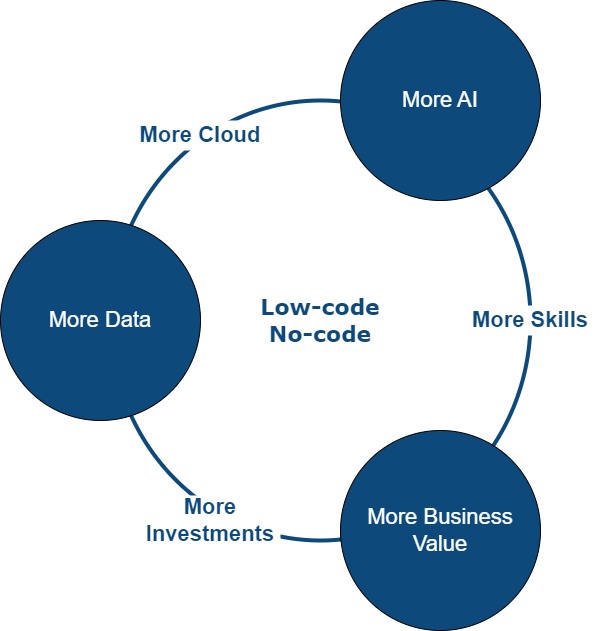Back in 2020 I was writing about an emerging trend, Diagrams as Code. Even made a full business plan for a startup to capitalize on this trend with a friend of mine – ALUMI®. Perhaps it’s the right time to review the idea and see where the trend is today.
From a technology trend perspective, I would include Diagrams-as-Code into a larger trend: the No-code / Low-code application development. Forbes actually named the No Code / Low Code The Most Disruptive Trend Of 2021. Perhaps there will be several years till will reach the plateau of productivity and mass adoption, but at the speed new technologies and methods develop these days, I argue that it’s going to happen sooner rather than later. There are a couple of compelling factors that will make that happen.
Cloud market mass adoption and it’s progress.
The cloud market naturally progressing from ‘Personal or Mass adoption’ to Utility – see Cloud Tough Leadership: The next cloud battles (which correctly predicted the 2023 and 2024 AI race). The role of technology in shaping future disruptions across industries, the competitive landscape of cloud computing which will put more and more pressure on its price pushing cloud computing towards becoming a Utility, and the new generations of skilled workers that progressively replace the old ones, will drive more adoption. Every industry will need more and more technology to protect itself from the emergent disruptors. And that will be reflected into their cloud spend as well as on their need for skills.
The relevant IT skills are scare and will not fulfill the market demand
As per The 10 Most In-Demand Skills In 2024 – Forbes, IT skills as Generative AI, Project Management, Data, Cloud Computing, Machine Learning Engineering, Cybersecurity are the most in-demand skills for 2024. I would make one remark to the article – traditional project management is dying, and I would rather replace the skill with the newer: Product Management. Notice that 6 out of 10 are IT related. With more and more companies experimenting, bringing to production, and harnessing AI technologies, the skills gap will only become bigger.
Fueled by the significance of embracing a product and platform operating model to drive innovation, enhance customer experiences, and achieve sustainable growth McKinsey: The big product and platform shift: Five actions to get the transformation right and one of its underestimated side effects: an increase in the need of IT skills spread across the organization, the No-code / Low-Code trend has the potential to increase organizations resiliency and agility McKinsey: The State of Organizations 2023
Generative AI accelerates the No-code / Low-code trend
As Why generative AI will turbocharge low-code and no-code development discusses, integrating generative AI into low-code and no-code development platforms can revolutionize software development. It highlights the benefits for business users and professional developers, such as natural language processing and autocade completion. While there are challenges, like ensuring effective prompts and addressing legal concerns, the integration could lead to a new class of developer technology and significant market growth. Key players like Microsoft, Amazon, Google, and Oracle stand to benefit.
Perhaps an old joke I had with a friend that by the time we’ll retire, software development will become obsolete is closer to become true than ever. Our bet was 2030, it will take a bit more, especially because of old-fashioned big companies technical debt, the lagging markets and local country regulations.
The Human Capital Solution: Citizen developers and Citizen data scientists
No-code/ Low-code makes concepts as citizen developer and citizen data scientists implementable in practice. According to Gartner, a citizen developer is defined as an employee who creates application capabilities for consumption by themselves or others, using tools that are not actively forbidden by IT or business units. A citizen data scientist is an individual within an organization who leverages data analytics and data science techniques to derive insights and make data-driven decisions, even though they may not have formal training or advanced expertise in data science.
Both will heavily benefit and depend on No-code / Low-code platforms.
The tools for the solution
The 2023 Gartner® Magic Quadrant™ for Enterprise Low-Code Application Platforms shows the players that provide the tools for the low-code solutions. The leaders as per now are: Microsoft, Salesforce, ServiceNow, Mendix, OutSystems, Appian, the challengers Oracle (APEX), visionaries: Oracle Visual Builder, Zoho, Betty Blocks, Pega and several niche players as: AgilePoint, AuraQuantic, Creatino, Newgen, TrackVia, Kintone, QuickBase, ProntoForms.
Gartner predicts that in the next 2-3 years the developers located outside of IT departments will increase their adoption of low-code development tools, supported by the integration of low-code development in strategic initiatives with an accelerated adoption driven by the demand for greater velocity in application delivery, coupled with a scarcity of technical talent and the emergence of hybrid or borderless workforces.
With Generative AI Low-code will become No-code.
Ultimately, generative AI will serve to help make low-code more no-code. It’s a logical conclusion, and the Generative AI could help low code evolve into no code – but with a twist article quotes several very smart people reaching the exact same conclusion. Here are two of them:
“Generative AI certainly appears to be another way for code to be automatically generated. It’s showing the potential to be a great aid in bridging the gap between the intent of a person and the computer programming required to solve a task.” Dr. James Fairweather, chief innovation officer at Pitney Bowes.
“One of the most significant benefits of generative AI is its ability to bridge the gap between low-code and no-code environments. By providing pre-built models and code templates, generative AI allows developers to create sophisticated applications without requiring extensive coding skills. This democratizes the development process and opens up opportunities for a broader range of individuals to participate in building technology solutions.” Oshri Moyal, cofounder and CTO at Atera.
More Data – More AI – More Business Value
There is a lot more to AI than just the hyper discussed Generative AI. Reading through All-in On AI: How Smart Companies Win Big with Artificial Intelligence by Thomas H. Davenport | Goodreads reconfirmed the ideas published back in 2021 Real World AI : A Practical Guide for Responsible Machine Learning by Alyssa Simpson Rochwerger | Goodreads:
AI initiatives need to get into production!
For this to happen, the All-in On AI: How Smart Companies Win Big with Artificial Intelligence by Thomas H. Davenport | Goodreads authors make a good job of listing the prerequisites:
- Creating a broad AI toolkit to support more AI use cases – enabling product teams to experiment, implement and capitalize on AI
- Building applications faster and better, incorporating automated machine learning (AutoML)
- Achieving a broad range of AI deployment at scale
- Harvest, manage and improve the data quality for model training
- Building or outsourcing a high-performance computing infrastructure for AI
- Improving IT operations for AI with AI – better (MLOps)
We live in a world where more and more data is produced every day. I encountered organizations who were caught off guard by the amount of data a new POC was generating and realizing quickly they need to do something with it. More data, fuels the need for More Cloud computing. All this data needs to be stored, processed, and at least labeled to be used by AI. Once in the cloud, the data enables More AI use cases which fuels the need for More skills to address more business cases and generate More Business Value. Value triggers More Investments that will generate More Data. It’s a virtuous circle.

The Solution in practice
As in most cases, the change already happens. It’s just that it hasn’t reached mainstream yet.
Looking at the above bullet points and comparing them with the potential of Brainboard: Cloud Infrastructure Designer which offers a No-code platform tailored for cloud infrastructure management that generates Terraform code as users design their infrastructure visually across multi-cloud environments. It enables citizen developers and citizen data scientists to adhere to IT standardization principles through importing Terraform modules and establishing naming conventions and shared variables. The platform integrates with CI/CD pipelines, prioritizing early issue detection and emphasizing security and cost optimization throughout the development cycle. Additionally, it supports scalability by facilitating the reuse of existing repositories, templating architectures, CI/CD pipelines, and role-based access controls while emphasizing the importance of maintaining a centralized source of truth for infrastructure configurations. Overall, the platform aims to automate and streamline cloud infrastructure management, ensuring consistency, security, and scalability from design to deployment and beyond.
Shall I also point you towards an article that highlights how a central IT organization can create a central digital platform that can enable all various product team? I’ll let you read the following article: How Chinese Companies Are Reinventing Management It explores how Chinese companies are redefining management practices through a concept termed “digitally enhanced directed autonomy” (DEDA). DEDA leverages digital platforms to grant frontline employees’ direct access to corporate resources, enabling them to organize around specific business opportunities without extensive managerial intervention. Chinese firms like Handu Group, Alibaba Group, and Haier Group exemplify DEDA by empowering autonomous teams, supporting them with digital platforms, and establishing clear, bounded business objectives. Western companies can learn from this approach by embracing autonomy at scale, leveraging digital platforms in the middle system, and focusing on clearly defined projects to enhance execution and decision-making. Additionally, Western firms may benefit from adopting aspects of Chinese management, such as single-threaded leadership and incorporating social incentives into their incentive systems.
And this can already be implemented in practice, this is what of Brainboard: Cloud Infrastructure Designer does. I would drive it for you for a lot of consulting money, or only if I direct it myself.
Disclaimer: Some portions of this text were obtained through summarizing the articles linked above utilizing ChatGPT (openai.com). Original sources are all mentioned, and a link is provided to them. I endorse the sources and I encourage you to selectively subscribe to them. The graphic is AI generated using Craiyon – Your FREE AI image generator tool: Create AI art! Big thank you to my free AI assistants!

